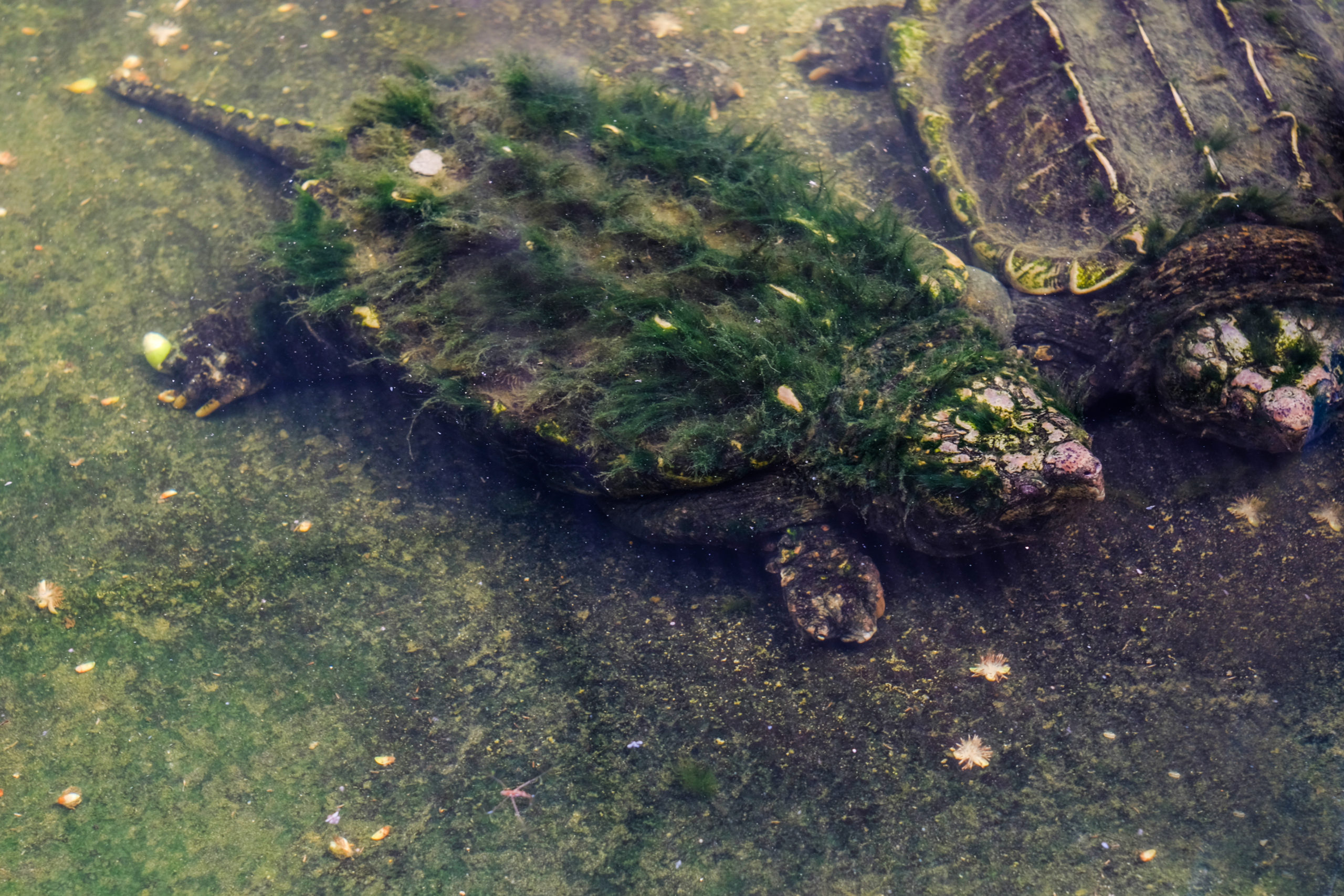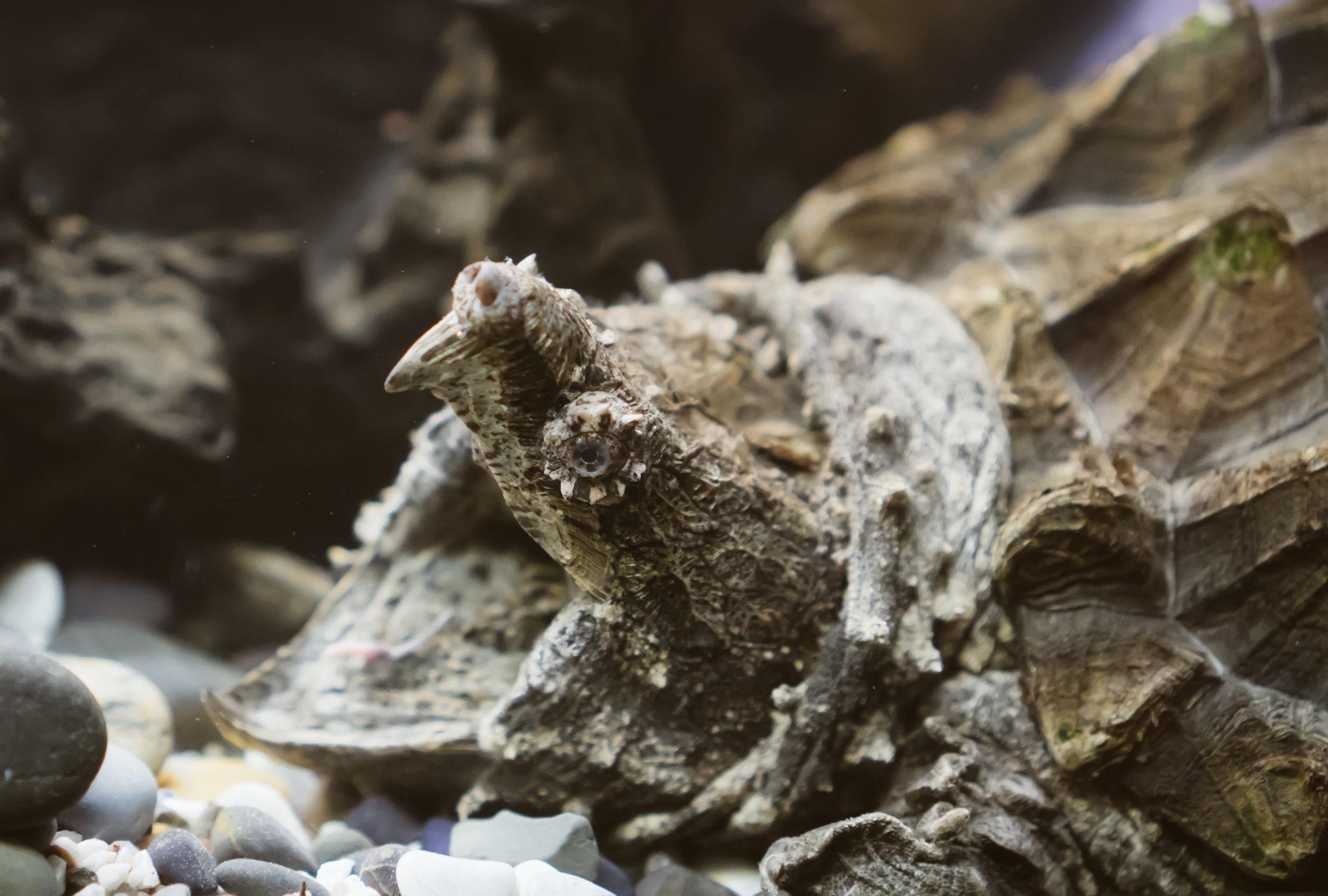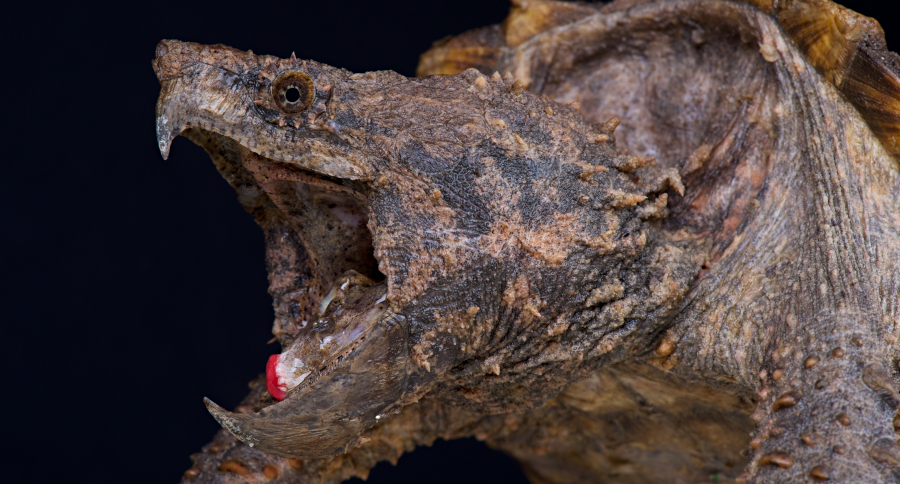The alligator snapping turtle is one of the most fascinating North American reptiles.
When it comes to reptiles of the United States, the alligator snapping turtle stands out in a crowd. With a face that only a mother could love, this animal is the largest freshwater turtle in the world. Alligator snappers have a limited range, powerful jaws, and a bad attitude.
Many myths and legends have sprung up about this species over the years and today we will attempt to cut through those and get straight to the facts in our full field guide.
From their diet, their habitat, and their conservation status, this is everything you ever wanted to know about the legendary alligator snapping turtle.
What does an alligator snapping turtle look like?

The best way to describe an alligator snapping turtle or macroclemys temminckii as it is known by the scientific name, is a dinosaur stuck in the wrong time. These animals' shells or carapace is dark and covered with big ridges or spikes called keels. These are usually arranged on the shell in three rows. The shell itself can be brown, green, or even black depending on the type of environment the animals are living in. It is not uncommon to see algae covering the entire carapace length. The underside of the shell, called the plastron, is not as heavily armored, nor does it cover as much of the animal's belly. This is simply because there must be more room for the turtle's feet to move and propel it through the water. Speaking of limbs, this turtle has large, muscular legs fitted with large claws that help it navigate the muddy and swampy environments it calls home. The legs and tail are covered with large, bony-looking scales that just add to the dinosaur appearance.
The large head of the snapping turtle is characterized by a sharp, hooked beak that helps it snare its prey. Inside the turtle's mouth is their distinctive tongues. This appendage of the turtle's body has a distinct worm-like appearance that has been perfectly designed by nature. By wriggling this tongue, the turtle can lure prey right into its mouth without having to expend any energy or effort.
These animals have a true prehistoric appearance and part of the reason is because they have been here in North America for forever. Audubon estimates both this species and its relative, the common snapping turtle, have been around for nearly 90 million years. Considering the dinosaurs vanished around 65 million years ago, that means the greater snapping turtle family watched the dinosaurs come and go from this earth.
How big can an alligator snapping turtle get?
As we have already noted, this is the largest freshwater turtle species on earth and the larger specimens often go wildly viral for their jaw-dropping appearance. Officially, the record, as noted by the U.S. Geological Survey was a specimen with a 31-inch carapace length. There are rumors out there of captures of 290-400 pound alligator snapping turtles, but most of these catches are unverified and likely exaggerated to some degree.
Most specimens are found to have shell lengths between 14-20 inches long and weigh anywhere from 20 to 100 pounds, but 200-pound specimens have been documented several times. For a while, a 249-pounder lived and thrived in the Shedd Aquarium in Chicago, awing everyone who saw it.
However, most turtles do not get near the 100-pound mark unless they are extremely old. In 2018, an angler caught and released one estimated to be near that mark in Alabama's Coosa River. Another giant that surely had to be close to that point made the Internet rounds in 2016. That turtle was caught in Texas.
How long does an alligator snapping turtle live?

Like most members of the turtle family, alligator snapping turtles are thought to be capable of reaching an extremely old age like tortoises and sea turtles. Scientists theorize that alligator snapping turtles between 80 and 100 years old are possible, although no one quite knows for certain. Captive specimens have been known to reach 70 years of age or more. It is theorized that alligator snappers may be able to live for 200 years or more, but instances of extreme old age like this are probably most uncommon in the wild.
Before you go wishing you were a turtle, also remember that the turtle must live long enough to reach an apex predator size first. Like the common snapping turtle, females may lay up to 50 or more eggs in a clutch, but most hatchlings will not make it to see their first birthday. Many will be picked off by birds, raccoons, fish, and more before they know what hit them. Only a handful may survive long enough to mate. Once they are grown, the main predator they have to deal with is humans. No one ever said snapping turtles have an easy life.
What is the range of the alligator snapping turtle?
While the common snapping turtle ranges over much of North America, the alligator snapper has a much more isolated home range that is centered mostly on the southern United States. They range throughout Mississippi, Arkansas, and most of Louisiana. These turtles can be found in the southeastern part of Georgia and throughout the Florida panhandle. Small populations also exist throughout eastern Texas, Oklahoma, western Kentucky, Tennessee, the corner of Kansas, and parts of Missouri.
The alligator snapper had a historic home range far up the Mississippi River to parts of Iowa and Illinois, but sightings are extremely rare in those two states today. In fact, the alligator snapper was thought to be completely extinct in Illinois until researchers caught one in 2017. Unfortunately, the GPS tracker attached to the animal failed and no one knows of the turtle's whereabouts today. Other states, like Indiana, have not had a confirmed sighting in nearly 30 years, leaving the state's DNR to conclude the animals are likely indeed extinct there.
According to the U.S. Geological Survey, this species has made some oddball appearances in places like Michigan, California, Arizona, and even Puerto Rico. One of the strangest appearances on this list, Virginia happened in 2020. These singular appearances are not thought to be signs of a thriving population. The alligator snapper has proven popular in the pet trade, leading many people to illegally release their pet turtles once they grow too large for their enclosures.
Habitat and diet of the alligator snapping turtle.

The alligator snapping turtle calls lakes, river drainages, and streams home most of the time. They are even commonly found in waters that drain into the Gulf of Mexico. This species spends slightly more time underwater than its relative the common snapping turtle. It is not uncommon to find them in nasty, slimy waters that most humans do not want to venture into.
That brings us to what alligator snapping turtles eat. Like the common snapper, they are not picky eaters. Their primary source of food is fish, but they will also cannibalize other turtles. Lizards, frogs, mice, muskrats, snakes, crayfish, tadpoles, baby alligators, and more are often on the menu. Like the common snapper, these turtles are omnivores, but they seem to prefer meat to any other food type including aquatic plants. They have also been known to scavenge dead animals, which is how they sometimes end up on the end of a catfish angler's line.
Whatever they eat, the alligator snapper is not one to go chasing after prey. They are much more likely to sit and wait for the food to come to them. Their dark, scaly appearance helps them blend into the bottom of riverbank or lake bottom and they either lure in prey with their tongue, or simply wait for it to swim by before striking quickly and efficiently.
Is the alligator snapping turtle endangered?
Unfortunately, this species is listed as "vulnerable" by the International Union for Conservation of Nature, mostly due to habitat loss and overhunting. The good news is that they have not been officially labeled as "endangered," yet, but this is a species that many state officials are watching closely.
In fact, most states have now put rules in their regulations officially protecting them. Punishments for those who violate the rules have often been stiff. In 2018, two poachers killed a 78-pound alligator snapper in Oklahoma and were promptly slapped with $989 in citations and an additional $5,000 in restitution fines each for killing an animal believed to be nearly 80 years old.
Most people have started to recognize the significance of this species and its importance to the natural ecosystems where it lives. With a little more public education, hopefully the alligator snapping turtle can make a full recovery into all the native areas where it once lived.
For more outdoor content from Travis Smola, be sure to follow him on Twitter and check out his Geocaching and Outdoors with Travis YouTube channels.
NEXT: PETA IS NOW GOING AFTER FISHERMEN
WATCH





